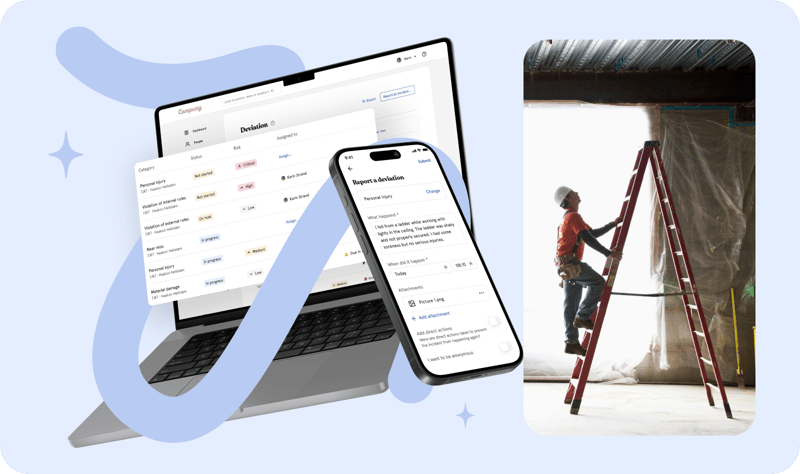1. You are looking for personnel information in difficult systems
A great deal of information comes as a consequence of having employees. Each individual employee has a number of formal documents related to their employment, and other information relating to sick leave, appraisal interviews and salary development for example, along with personal information such as addresses and account numbers also needs keeping up to date.
It does not take very long before Excel documents become complex and difficult to navigate. At the very beginning of a company's life, there may be only a few employees, and it may be possible to maintain a fairly good overview of the information related to the staff. We believe, however, that even start-up companies should consider using a digital HR system.
As a company grows, so does the amount of information relating to human resource management. And if there is one thing most CEOs acknowledge, it is that time is a scarce resource. Bearing that in mind, setting up personnel information in a digital HR system once only and never having to re-do it amounts to solid advice. It means that all information relating to the employees and the company's routines is easily accessible when needed. So don’t waste valuable time looking for information in a cluttered folder structure or in unnecessarily complex spreadsheets.

2. You repeat the same tasks over and over again
Some personnel information is always ‘in motion’. Home addresses of employees and which account numbers their salaries are to be paid to are good examples, while information about time off and absence is almost constantly changing. Registration of applications for holidays, staff calling in sick and actual sick leave quickly becomes a lot for one individual to manage. If you find yourself doing the same job – registering absences on behalf of your employees – over and over again, is it perhaps time to consider letting employees do this themselves?
Allowing employees access to registration of absence means they can register applications for leave and self-declarations and view a balance of how many days have been spent or otherwise. This not only makes it much easier for managers, who can then approve applications directly from their cellphone, it also means the personnel history is always updated. This way you can avoid doing the same task over and over again.
3. You work like a computer
There are many things computers are really bad at. Like, for example, making employees feel seen and valued, facilitating conversations that help both company and employees achieve their goals or ensuring employees feel motivated for the job they are to carry out. All these things are much better done by people.
What computers are completely unmatched at is handling concrete information in an accurate and efficient manner. It seems strange, then, that so many managers spend so much time working as if they were a computer. Today, it is not uncommon for a person to be given the task of retrieving information from one system in order to paste it into another. This should, however, be a rarity. Take recruitment as an example. It is quite possible that a company might be using a recruitment tool through which candidates are asked to provide some information about themselves. After the candidate has been given the job, this information must be entered in the personnel file of the new employee. A good digital solution ensures there is no need for a human link between these two systems.
When the consultancy company Appear was about to embark upon a large-scale recruitment drive, this capability was deemed very important. They had to become "super professionals" in recruitment and could not spend time copying and pasting information about their new employees. They chose a solution where they used Teamtailor for recruitment and Huma as their HR system. The reason for doing so was the integration between the systems enabling seamless data flow. You can read all about how Appear used smart systems to radically change their company here.
Don’t spend time working like a computer; technological development has come far enough to allow much smarter solutions.
4. Appraisal interviews have become symbolic
Appraisal interviews can be the beating heart of a company’s culture. Indeed, such exchanges may be precisely where managers gain true insight into what is going on among the employees in a workplace. For employees, such conversations may be crucial to motivation, commitment and, in extreme situations, whether an individual wishes to resign or remain in a job. What is important for both the employee and the company, however, is that such conversations provide value. An employee does not need a symbolic conversation from the company’s side after which the content is inadequately followed up. Similarly, the company needs the conversation to boil down to the truth about what is going on in the employee's head. If both parties agree on an agenda in advance and show up prepared for what is to be discussed, a great deal has already been done to ensure the conversation will be of value to both parties.
Here you can read more about how we believe you can get maximum value out of your appraisal interviews: what should be prepared, how the interview should take place, and what to do afterwards.
5. Receiving new employees is stressful
To put it mildly, there is an awful lot to remember when welcoming new employees, and we guarantee subsequent results will inevitably reflect if important things are forgotten. That’s why it may be a good idea to work with good onboarding templates or checklists. Draw up checklists for different positions since one particular position will require different onboarding tasks from another. Simplify processes too by setting up onboarding paths once and then using them again and again. This will save you time and, not least, money. We like to divide the onboarding process into four phases: pre-boarding, the first day, the first months and the first year. To make it even easier for you, we have also divided the list into the different phases. You’ll have to try very hard to forget anything.
This is a good example of how having a dependable digital HR system can help you focus on the most important things when kicking-off with a new colleague. This first period is incredibly important and will affect the entire employment relationship in the time that follows. Make sure you have a system that helps you be good at the important things. We have a whole bunch of thoughts and opinions about how successful onboarding should be done, and you can read more about them here. If you find receiving new employees stressful and are afraid of forgetting important things in the first phase, it may be a good idea to have a system help you along the way.







